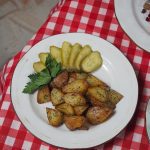Get The Most Out of Your Tarragon from Backyard Eats
Harvesting Tarragon
When It’s Ready
- Tarragon is ready when the plant is at least 4″ tall.
- Harvest no more than one-third of a plant at a time to allow continued regrowth.
- Harvest midmorning, after the sun has dried the leaves but before it gets too hot.
- April – November
How To
- Cut with scissors or pruners about one-third down the length of a main stem
- Or clip off an entire branch.
- Clipping a main stem will induce branching at that point, resulting in a bushier plant.
- Removing an entire branch will reduce bushiness and encourage more upright growth.
About Mediterranean Herbs
Mediterranean herbs are plants that grow 0.5-3 ft tall. They require partial to full sun to thrive, but not trellising or pruning.
Flowering/Fruiting Tendencies
Mediterranean herbs are easy, multi-harvest plants for fresh use, drying, teas, and medicines. Most are typically easy to establish and just need seasonal clean-ups.
Design Notes
Space herbs about 18″ apart. Most are Mediterranean herbs don’t do well in super cold or moist soil. Will overwinter better in warm conditions.
Care Notes
Kitchen herbs benefit from compost. Mulching can be kept to a minimum as many kitchen herbs won’t benefit from the extra moisture retention. Kitchen herbs can typically be thinned/harvested in the summer and fall to keep them from growing wild. Many will get unwieldy and less productive after a few years and may need to be replaced.
Newly planted perennials require some additional care to help establish and support the plants as they grow. Water newly planted perennials deeply at the root 2-3 times a week during the first growing season. Apply compost and wood chip mulch in the late winter/early spring.
Storing Tarragon
Fresh Storage: Wrap in damp paper towel and place in a ziploc bag in the crisper drawer of the refrigerator for storage up to three weeks.
Long-Term Storage: “Woody” perennial herbs like tarragon can be dried at home to enjoy all year long! First, trim stems from the main plant. Tie 3-5 stems together into a bundle, then hang them to dry in a cool, dark, and well-ventilated place for 2-3 weeks.
Once the herbs are dry and brittle, you can store and enjoy them long-term.

Cooking With Tarragon
- Tarragon Chicken Salad: Mix cooked and shredded chicken with mayonnaise, chopped tarragon leaves, diced celery, and a squeeze of lemon juice. Serve the flavorful chicken salad on sandwiches, wraps, or atop a bed of greens.
- Tarragon Butter: Blend softened butter with minced tarragon leaves, lemon zest, salt, and pepper. Use the tarragon butter to melt over grilled meats, roasted vegetables, or spread it on warm bread for a burst of herby goodness.
- Tarragon Vinaigrette: Whisk together minced tarragon, Dijon mustard, white wine vinegar, olive oil, salt, and pepper to create a tangy and aromatic tarragon vinaigrette. Drizzle it over salads, roasted vegetables, or use it as a marinade for grilled fish or poultry.
- Tarragon Roasted Potatoes: Toss halved baby potatoes with olive oil, minced tarragon leaves, garlic, salt, and pepper. Roast until the potatoes are crispy and golden, allowing the tarragon to impart a unique flavor to the dish.
- Tarragon Potato Salad: Toss cooked and diced potatoes with a mixture of mayonnaise, Greek yogurt, chopped tarragon, Dijon mustard, lemon juice, salt, and pepper. This creamy and herb-filled potato salad is a refreshing side dish for picnics or barbecues.




